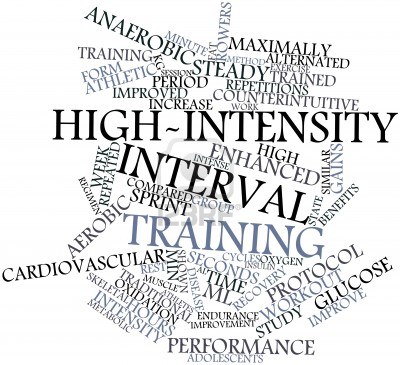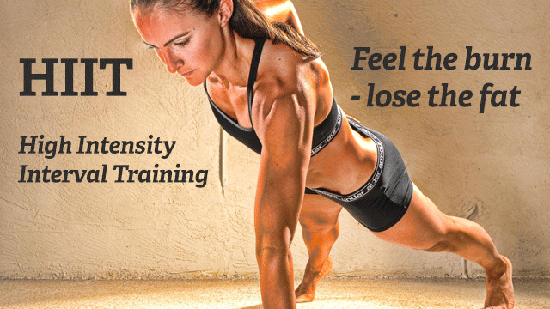Burn Fat Fast with High Intensity Interval Training (HIIT)

High Intensity Interval Training (HIIT)
If I told you there was a way to burn calories, lose more fat and improve your cardiovascular fitness by working out for a shorter amount of time you would probably look at me skeptically or think I was mad right?
Well here’s a few typical questions I face every week. What’s the fastest way to lose weight? How can I lose fat fast? I have limited time to train what do you suggest I do to get in shape? The list goes on but I think the real question is 'What is the least time I can spend working out with the maximum fat loss and physical benefits?'
My answer? Have you considered High intensity interval training or HIIT for short?
What’s that? Let me explain, but before I do let me just state that I am not a believer in fitness fads, crash diets or get thin fast regimes. My approach to health and fitness is to provide an all round maintainable way of life that will take you to your goals be it to gain muscle, increase endurance or lose fat or anything in between and to have fun along the way. However I am a believer in achieving the maximum possible results in the shortest amount of time and if stripping off body fat is your goal then HIIT can help you do just that.

It sounds too good to be true?
Well, this is one of those rare times when your natural it’s-too-good-to-be-true reaction could be mistaken. If you want to take your fitness and fat loss to the next level—without spending more time in the gym—then high intensity interval training (also known as HIIT) could be exactly what you're looking for.
What Is It? And how does It Work?
So HIIT involves intervals of high intensity exercise (such as running sprints) followed by low intensity intervals or complete rest. This is in sharp contrast to the typical steady rate cardio most people do at a moderate intensity such as jogging on a treadmill, etc. HIIT was originally developed by sports coaches to train runners and athletes and improve performance. But it crossed over to the fitness industry due to it’s fat burning benefits confirmed many times over in scientific studies. The findings of all of these studies showed that HIIT burned significantly more body fat in less time than tradition steady rate cardio.

Before getting into the details, notice that I didn’t say HIIT would be easier, just that it would take less of your time. In fact, the HIIT approach to cardio exercise is very physically demanding and isn’t for everyone. If you have any cardiovascular problems or other health concerns that limit your ability to exercise at very intense levels, or if you are relatively new to aerobic exercise then HIIT may not be for you —at least for now. Now here’s the disclaimer If you have any doubts or concerns about whether it might be safe for you, check in with your medical professional before trying HIIT.
Now here is the best bit, after a HIIT session science has proven that you burn more calories and more body fat for the rest of the day. Yes you heard me right, due to the greater calorie burn (EPOC-excess post exercise oxygen consumption) that’s maintained after the workout your body continues to burn calories. For want of a better phrase the after burn increases your resting metabolic rate and enhances the mechanisms in muscle cells that promote fat burning and fat storage. This training principle can be applied to any form of exercise that you enjoy, from running to weight training.
Here is a great link from the BBC program Horizon titled ‘The Truth About Exercise’
http://www.youtube.com/watch?v=v7-h_w7bJrU
The whole documentary is available online and I think you will find it fascinating. I personally think there is a balance to be struck between HIIT, lower level cardio and resistance training (weights etc) for an all around balanced approach to health and fitness. When working with a new client the first thing I try to do is establish what their specific goals are so their personal fitness plan can be tailored to this end. But HIIT can definitely give you an edge and I use it a lot with my clients because HIIT trains and conditions both your anaerobic and aerobic energy systems. You train your anaerobic system with brief, all-out efforts, like when you have to push to make it up a hill, sprint the last few hundred yards of a distance race for that big finish or when a fighter has a guy on the ropes and needs that final effort to finish off he’s opponent.
HIIT causes metabolic adaptations that enable you to use more fat as fuel under a variety of conditions. This will improve your athletic endurance as well as your fat-burning potential.
HIIT appears to limit muscle loss that can occur with weight loss, in comparison to traditional steady-state cardio exercise of longer duration.
To get the full benefits HIIT, you need to push yourself past the upper end of your aerobic zone and allow your body to replenish your anaerobic energy system during the recovery intervals.
General HIIT Guidelines
HIIT is designed for people whose primary concerns are boosting overall cardiovascular fitness, endurance, and fat loss, without losing the muscle mass they already have. Before starting any HIIT program, you should be able to exercise for at least 20-30 minutes at 70-85% of your estimated maximum heart rate, without exhausting yourself completely or having any problems.
Because HIIT is physically demanding, it’s important to gradually build up your training program so that you don’t overdo it. Always warm up and cool down for at least five minutes before and after each HIIT session.
Work as hard as you can during the high intensity intervals, until you feel the burning sensation in your muscles, for maximum results these bursts of energy should be a true sprint and almost maximum capacity.
If your heart rate does not drop back down to about 70% of your max during recovery intervals, you may need to shorten your work intervals and/or lengthen your recovery intervals.
But I enjoy regular cardio?
The good news is you don’t need to swap all of your aerobic exercise for HIIT to gain the benefits. A good balance, for example, might be one or two sessions of HIIT per week, along with 1-2 sessions of steady-state aerobic and or resistance training. As usual, moderation is the key to long-term success, so challenge yourself—but don’t drive yourself into the ground. But as with many of my clients do get ready to see major changes in your body and your fitness level!







